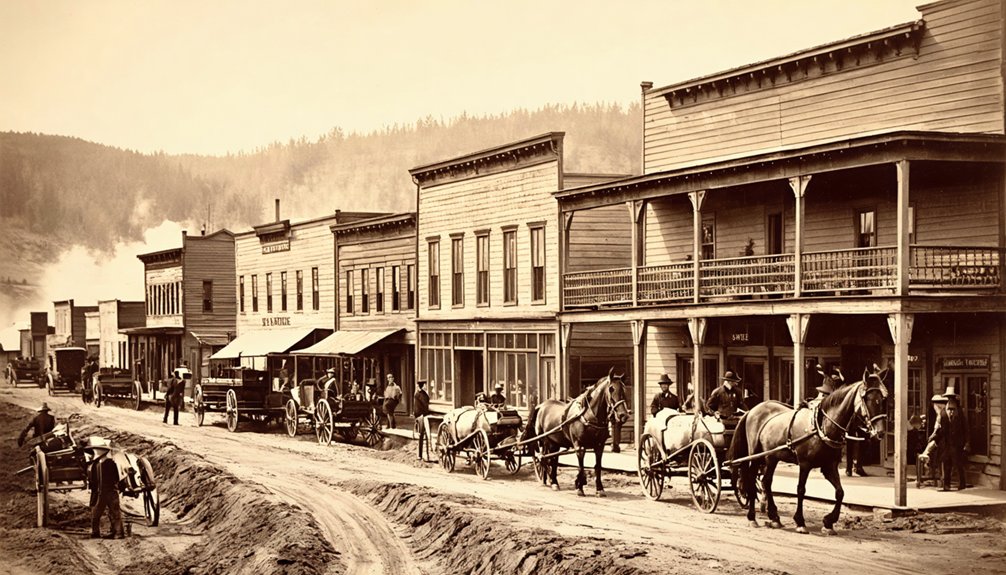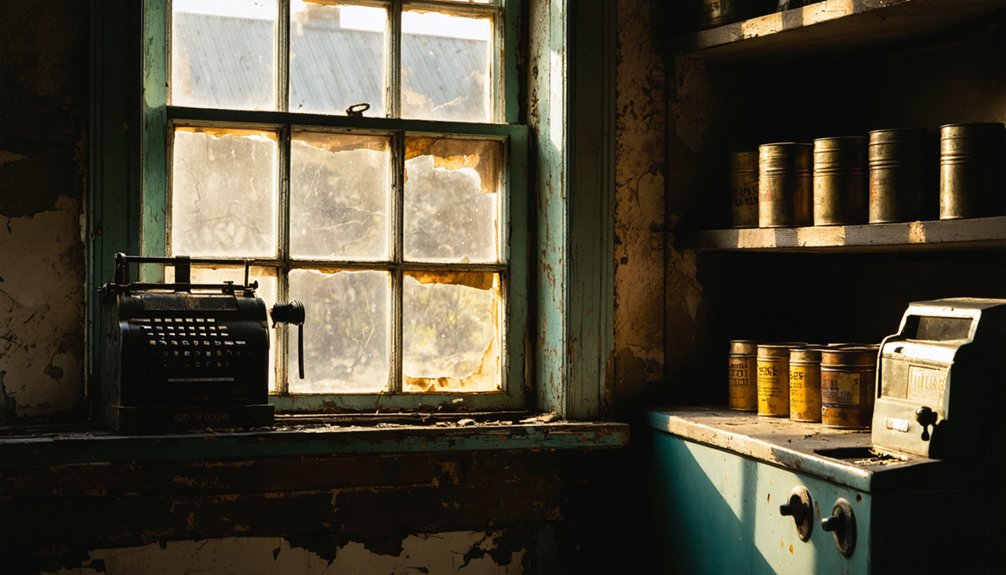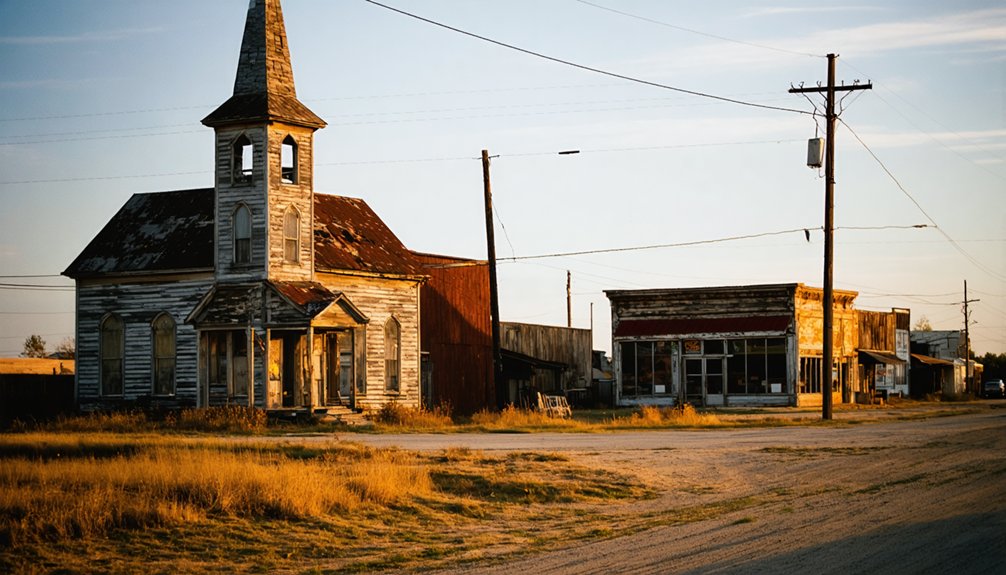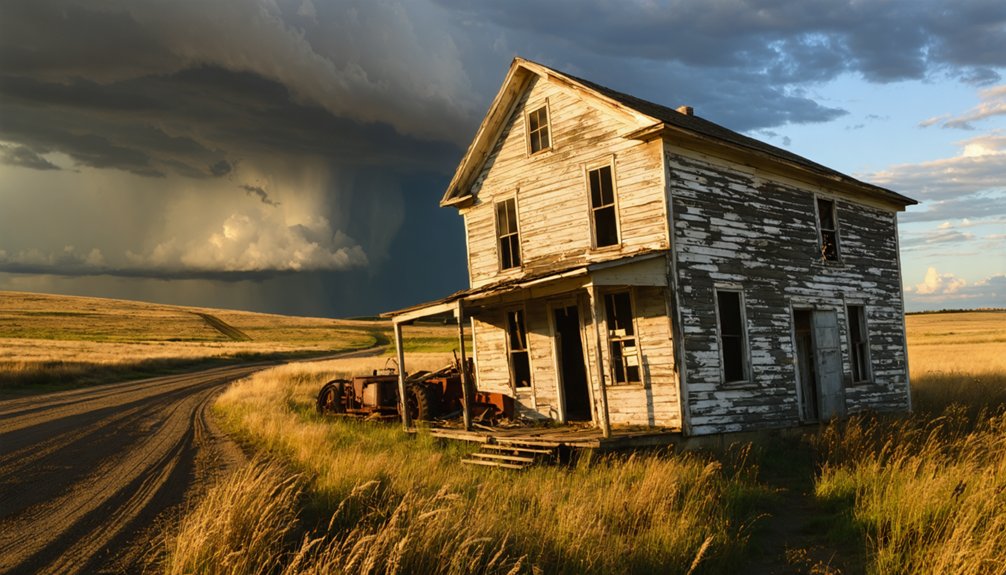You’ll find Greenwood’s ghost town remains in South Dakota’s Black Hills, where it emerged as a gold mining settlement in 1885. The town thrived with innovations like chlorination plants for processing low-grade ore and gained prominence when the standard-gauge railroad arrived. A catastrophic mine fire in 1912 killed Robert Flormann and triggered the town’s decline. Today, you can explore scattered building foundations, mine remnants, and a historic cemetery that tells a deeper story.
Key Takeaways
- Greenwood was established as a South Dakota mining settlement in 1885 following the discovery of gold by Jenney and Newton.
- The town featured essential facilities including a post office, general store, boarding house, and single-room schoolhouse for mining families.
- A catastrophic mine fire in 1912, which killed Robert Flormann, triggered the town’s decline and eventual abandonment.
- Miners endured harsh living conditions in wooden cabins and tents, facing severe winters and poor sanitation while working the mines.
- Today, visitors can explore building foundations, mine remnants, and a historic cemetery, though proper safety equipment is necessary.
The Birth of a Mining Town (1885)

In 1885, Greenwood emerged as one of several mining settlements in South Dakota’s Black Hills during the region’s gold rush era.
You’d have found prospectors and seasoned miners, many veterans of earlier rushes in California and Montana, tackling the founding challenges of transforming a rugged camp into a proper town. The settlement quickly grew around promising gold claims, where mining innovations like chlorination plants helped extract precious metal from stubborn low-grade ore. The discovery of gold by Jenney and Newton in 1875 had set the stage for this mining boom.
As you’d expect in a frontier boomtown, merchants and service providers soon followed the miners, establishing the backbone of a new community. The arrival of the standard-gauge railroad that year marked a significant advancement in the town’s development.
When the railroad arrived and a post office opened that same year, Greenwood’s evolution from camp to town was complete, now connected to essential supply routes and the expanding American West.
Daily Life in Early Greenwood
You’d find daily life in Greenwood centered around basic survival needs, with residents living in simple log cabins or sod houses while drawing water from the Missouri River or local wells.
The community relied heavily on churches and schools as social anchors, where gatherings, festivals, and barn raisings provided much-needed recreation and mutual support. Like many South Dakota settlements, fur trading posts drove initial economic activity in the area. The severe hardships faced during the Great Depression made these community bonds even more crucial for survival.
Despite harsh weather conditions and isolation, Greenwood’s size as the largest settlement between Yankton and Chamberlain meant you could access essential services like the general store, blacksmith, and post office – though most residents practiced subsistence farming and bartering to meet their daily needs.
Mining Workers’ Living Conditions
Life in early Greenwood tested the limits of human endurance, as miners endured harsh living conditions while pursuing their dreams of striking it rich. You’d find yourself crammed into a basic wooden cabin or tent with several other workers, often on disputed land with no clear ownership rights.
These makeshift shelters offered little protection from the brutal Black Hills winters, and proper insulation was rare. The living conditions created severe health hazards. You’d battle constant exposure to lice, vermin, and diseases due to poor sanitation. Without proper medical care, injuries and illnesses often went untreated. Just like the notorious town of Deadwood in 1876, Greenwood began as a tiny mining camp that grew rapidly as prospectors sought their fortunes.
Your home might be nothing more than a canvas tent or crude dugout, where you’d cook basic meals over an open fire after exhausting 12-hour shifts. Like many of the six hundred ghost towns scattered throughout the Black Hills region, these primitive dwellings now exist only as deteriorating foundations. Privacy was nearly non-existent, and you’d share your limited space with other workers just to afford shelter.
Community Services and Support
Despite its remote location, Greenwood developed essential community services that helped transform the mining settlement into a more stable town.
You’d find community connectivity centered around the post office, established in 1885, where residents gathered to exchange news while collecting mail. Similar to many railroad supply towns, these services were strategically placed to support the growing population. Like the town of Awanka, Greenwood once had two busy hotels catering to travelers and workers.
The town’s educational impact emerged through its single-room schoolhouse, providing children with basic literacy and skills needed for mining town life.
- A general mercantile store supplied daily necessities and served as a social hub
- The local boarding house provided lodging and meals for the mining workforce
- A blacksmith shop supported critical mining and transportation repairs
- The post office facilitated communication with the outside world
- The schoolhouse offered structure and stability for mining families
Social Activities and Recreation
While mining dominated work life in Greenwood, the community found diverse ways to maintain social connections and enjoy recreational pursuits. You’d find residents gathering for town fairs, picnics, and harvest festivals that strengthened neighborhood bonds. Like the residents of Terry in Lawrence County, the population embraced both work and leisure with equal enthusiasm.
During these community gatherings, you could experience local music, dance, and the sharing of regional stories and legends. Nuttal and Mann’s saloon became a popular destination for entertainment and socializing after long days in the mines.
Leisure activities centered around the natural surroundings, with hunting and fishing being popular pastimes. The town’s open spaces hosted sports events and games, while taverns served as social hubs where miners could unwind.
You’d also find residents participating in community theater performances, horse racing events, and various clubs. Through volunteer work and community projects, Greenwood’s citizens maintained strong social ties despite the demanding nature of mining life.
Economic Foundation and Industry
As a mining community established in 1885, Greenwood’s economy centered almost exclusively on gold extraction, though its mines never generated substantial profits beyond operational costs.
The economic challenges stemmed from limited diversification and complete dependence on mining operations. While Robert Flormann amassed personal wealth through mine promotion and investment, the broader community saw little financial benefit from their mining legacy.
- Local ore processing facilities supported the primary mining operations
- Transportation infrastructure, including rail lines to Deadwood, served mining interests exclusively
- Essential services emerged to support mining operations, including stores and boarding houses
- No formal town planning existed, with all development occurring on mining company land
- Workforce remained largely transient, following the ebb and flow of mining opportunities
The Inevitable Decline

Once the gold mines failed to generate profits beyond basic operational costs, Greenwood’s decline became unavoidable. The town’s economic shifts revealed a stark reality: without diversified industries or mining expansion, you’d find no sustainable future.
A devastating mine fire in 1912 killed Robert Flormann during a rescue attempt, accelerating the community’s downward spiral.
You can trace how the town’s community resilience crumbled as essential services vanished one by one. The store, school, post office, and boarding house all closed as residents sought opportunities in larger Black Hills settlements like Deadwood and Lead.
What Remains Today
Today you’ll find little more than scattered building foundations and mine remnants at Greenwood’s former location, where nature has steadily reclaimed the once-bustling mining settlement.
The site’s physical remnants tell a story of its mining past, with the mine structure being the most prominent feature among the ruins. Historical markers help visitors piece together the town’s legacy, though they’ll need to navigate carefully through the abandoned landscape.
- Explore the mine’s remaining structure, the most significant architectural survivor
- Discover old building foundations that outline the former town layout
- Observe ash heaps and rubble marking previous settlement areas
- Notice how natural vegetation has overtaken former streets and lots
- Search for historical markers that provide context about the town’s past
Notable Historic Landmarks

While many Black Hills ghost towns have faded into obscurity, Greenwood’s historic landmarks offer tangible connections to South Dakota’s mining heritage.
You’ll discover remnants of the town’s mining infrastructure, including deteriorating wooden structures and abandoned mill foundations that highlight its archaeological significance. The town’s historic cemetery serves as a poignant memorial to early settlers and miners, featuring markers that range from simple wooden crosses to elaborate stone monuments.
Throughout the area, you can explore the remaining historic structures that paint a picture of frontier life during the region’s mining boom.
These landmarks are part of a broader collection of over 600 documented ghost towns in the Black Hills, each preserving vital evidence of the area’s industrial past and pioneer spirit.
Exploring the Ghost Town Safely
To guarantee a safe exploration of Greenwood’s historic sites, you’ll need proper preparation and equipment before venturing into this remote Black Hills ghost town. Pack essential safety gear including navigation tools, emergency communication devices, and wilderness first aid supplies.
Stay vigilant of wildlife, particularly prairie rattlesnakes common to the area, and maintain safe distances from any animals you encounter.
- Bring maps, compass, and GPS devices to navigate the rugged terrain
- Travel in groups and inform someone of your exploration plans
- Wear appropriate clothing and footwear for changing weather conditions
- Keep emergency communication devices ready for quick access
- Follow established trails and respect property boundaries
Remember to monitor weather conditions closely, as Black Hills storms can develop suddenly.
Always carry sufficient water and stay on marked routes to avoid hazardous terrain while preserving the site’s historic integrity.
Frequently Asked Questions
Were There Any Notable Crimes or Shootouts in Greenwood’s History?
You won’t find records of major crime incidents or shootout history in this town’s documented past. While mining accidents occurred, including Flormann’s fatal rescue attempt, violent crimes weren’t prominently recorded.
What Native American Tribes Originally Inhabited the Greenwood Area?
You’d expect a simple answer, but Native settlements in this area were primarily Lakota and Dakota Sioux peoples, whose rich cultural heritage dominated the region long before European settlement began.
Did Any Famous Historical Figures Ever Visit Greenwood?
You won’t find records of any historical visitors or notable residents passing through. The town’s significance was purely in its mining operations, and it didn’t attract famous figures before its 1912 abandonment.
What Was the Average Temperature and Weather Like in Greenwood?
You’d experience a humid continental climate with strong seasonal variations, averaging 58°F highs and 35°F lows annually. Winters drop near 0°F, while summers reach 83°F with moderate rainfall.
Were There Any Significant Gold or Silver Discoveries Near Greenwood?
All that glitters isn’t gold, but you’d find significant discoveries during the Black Hills gold rush near Lead and Deadwood, with mining techniques evolving from placer to hard-rock extraction around Greenwood’s vicinity.
References
- https://www.youtube.com/watch?v=Glucs_Rq8Xs
- https://www.youtube.com/watch?v=_0WNYsFLSLA
- https://www.sdhspress.com/journal/south-dakota-history-2-2/some-black-hills-ghost-towns-and-their-origins/vol-02-no-2-some-black-hills-ghost-towns-and-their-origins.pdf
- https://www.sdpb.org/rural-life-and-history/2023-08-21/some-black-hills-ghost-towns-and-their-origins
- https://www.blackhillsbadlands.com/blog/post/old-west-legends-mines-ghost-towns-route-reimagined/
- https://www.ghosttowns.com/states/sd/greenwood.html
- https://en.wikipedia.org/wiki/List_of_ghost_towns_in_South_Dakota
- https://b1027.com/south-dakota-has-an-abundance-of-ghost-towns/
- https://www.sdhspress.com/journal/south-dakota-history-2-3/the-boom-and-bust-of-central-city/vol-02-no-3-the-boom-and-bust-of-central-city.pdf
- https://history.sd.gov/museum/docs/Mining.pdf



